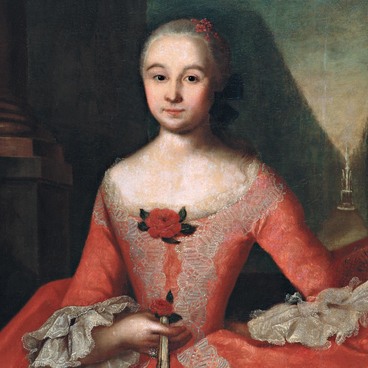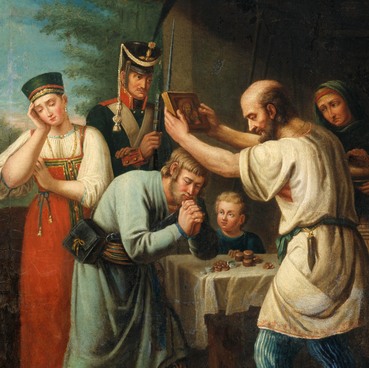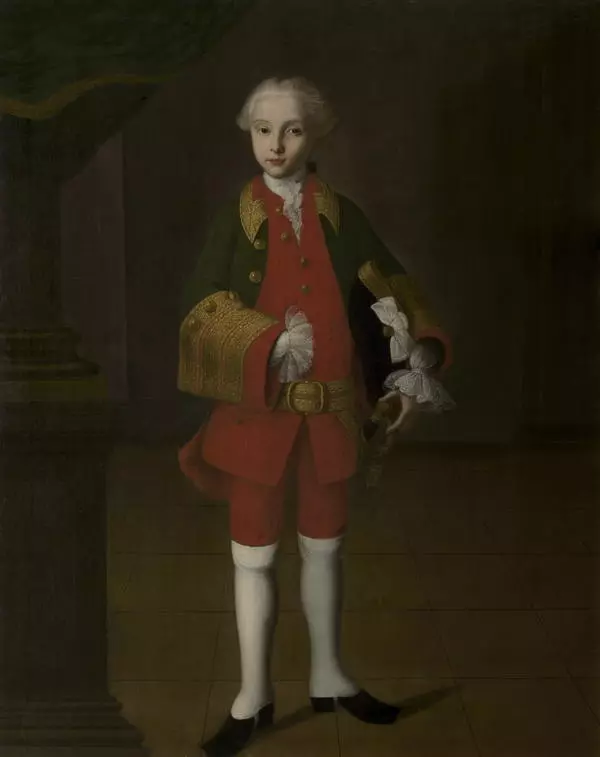Russian portraitist, iconographer and decorator Ivan Vishnyakov was born in 1699 in a family of craftsmen. His creations peculiarly unite the traditions of Russian middle age art and features of European rococo. Vishnyakov studied under Louis Caravaque, a French master that introduced Russia to this style.
Vishnyakov worked in Petersburg for the majority of his life, where he led a team of decorative painters for nearly 25 years. His famous students include artists such as Aleksey Antropov, Ivan Firsov, and brothers Ivan and Alexei Belsky. He painted palaces and churches, and icons, and created projects of triumphal archs, coronation outfits, and theatre sceneries together with them. Particularly, the artist worked on the decoration of the Winter Palace, the Peterhof Palace and the Anichkov Palace. In 1740, the civil title of a court councillor was bestowed upon him. In 1752, the title of collegiate assessor was given to him as well.
There are around ten portraits painted by Vishnyakov that survived to our time, and only two of them have the owner’s signature: back then, Russian painters rarely signed their paintings. Both of these paintings are in the Rybinsk State Historical, Architectural and Art Museum Preserve.
Vishnyakov depicts Nikolai Tishinin, the founder and owner of the Tikhvino-Nikolskoe manor (which is located on a territory of contemporary Yaroslavl Oblast), in this portrait. In 1755, Tishinin received a long-awaited officer rank, Ober-officer. To mark the occasion, a famous master from the capital was commissioned to paint a ceremonial portrait. Having connections in the court, Tishinin commissioned Vishnyakov to paint a portrait of himself and his wife Ksenia.
Tishinin left his servitude in rank of captain and occupied himself with the improvement of his manor. He was highly educated and ambitious, so he participated in the planning of his manor and the architecture development of the buildings himself. He had been corresponding with many famous masters in regard to this: Vasiliy Bazhenov, an architect, Mikhail Makhaev, an engraver from Petersburg, and Mina Kolokolnikov, a Russian portrait painter. The territory of the manor included the main house, a church, outbuildings and terraced park. The manor is currently neglected.
Vishnyakov worked in Petersburg for the majority of his life, where he led a team of decorative painters for nearly 25 years. His famous students include artists such as Aleksey Antropov, Ivan Firsov, and brothers Ivan and Alexei Belsky. He painted palaces and churches, and icons, and created projects of triumphal archs, coronation outfits, and theatre sceneries together with them. Particularly, the artist worked on the decoration of the Winter Palace, the Peterhof Palace and the Anichkov Palace. In 1740, the civil title of a court councillor was bestowed upon him. In 1752, the title of collegiate assessor was given to him as well.
There are around ten portraits painted by Vishnyakov that survived to our time, and only two of them have the owner’s signature: back then, Russian painters rarely signed their paintings. Both of these paintings are in the Rybinsk State Historical, Architectural and Art Museum Preserve.
Vishnyakov depicts Nikolai Tishinin, the founder and owner of the Tikhvino-Nikolskoe manor (which is located on a territory of contemporary Yaroslavl Oblast), in this portrait. In 1755, Tishinin received a long-awaited officer rank, Ober-officer. To mark the occasion, a famous master from the capital was commissioned to paint a ceremonial portrait. Having connections in the court, Tishinin commissioned Vishnyakov to paint a portrait of himself and his wife Ksenia.
Tishinin left his servitude in rank of captain and occupied himself with the improvement of his manor. He was highly educated and ambitious, so he participated in the planning of his manor and the architecture development of the buildings himself. He had been corresponding with many famous masters in regard to this: Vasiliy Bazhenov, an architect, Mikhail Makhaev, an engraver from Petersburg, and Mina Kolokolnikov, a Russian portrait painter. The territory of the manor included the main house, a church, outbuildings and terraced park. The manor is currently neglected.




